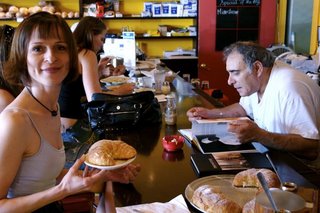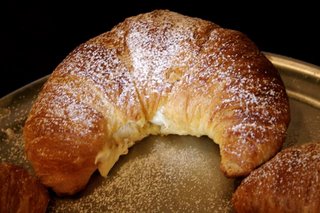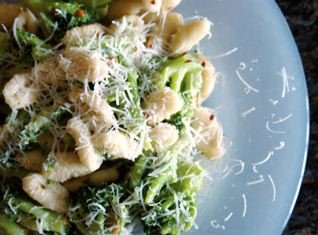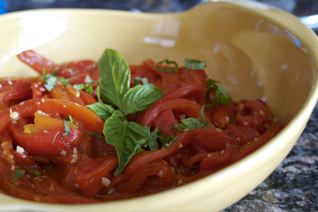Risotto #3:
First, an explanation of the risotto number. To give us confidence about making risotto, Andrea Trapani told us that you need to make risotto 20 times to get it right. I had made risotto before studying at Apicius, but in light of everything I learned there, I now think that those experiences do not really count. So, I will start my count with the risotto that we made in Andrea's class. Since our first effort was not very successful, he had us make risotto a second time. This time, most teams did better, but there was still a lot of room for improvement. So, counting those two risottos, now I will recount my third experience making this velvety comfort dish.
My third risotto try was a recipe from one of the cookbooks published by Apicius. The book, titled Innovations: New Appetites in the Tuscan Kitchen, contains recipes by Duccio Bagnoli and Simone Riani, two of the talented chefs and instructors who make Apicius a special place. Both provide new and original interpretations of a number of traditional Tuscan recipes, using their individual cooking styles and preferences. The book provides the traditional recipe first, followed by the reinterpretation of each chef. Each reinterpretation recipe is accompanied by a mouth-watering photograph and suggested wine pairings. The photography makes you want to try even recipes that you would normally not care about. The risotto photograph made me want to try it even though the temperature outside is somewhat high.
I tested Simone's recipe for risotto con piselli e prosciutto (risotto with peas and prosciutto), with slight modifications. I did not use the pea puree on which the risotto is supposed to rest for two reasons: I didn't have any peas and time was short and my dinner companion, and faithful taste tester, is not really enamored of peas (although, to his credit, he has agreed to try the risotto with the pea puree also). So, no pea puree for now. I also had to resort to using rosemary prosciutto cotto from Trader Joe's as regular prosciutto cotto is not easy to come by (not the good kind anyway). I find Trader Joe's rosemary prosciutto cotto very flavorful, but it is sliced somewhat thinly. This is perfect if you're making sandwiches, but for this risotto I'd like to try prosciutto cotto in somewhat thicker slices for the chew factor. The prosciutto is sautéed for more flavor and to make it crispy, a nice contrast to the smooth and creamy risotto.
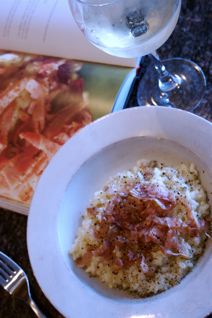
As you might have read in some other posts in this blog, my cooking partners and I had some difficulties with risotto in Andrea Trapani's course. To be more specific, we had difficulties reaching the level of perfection Andrea aspires to. Our risotto was quite decent, but it was very far away from the standard set by Andrea: a perfectly cooked, creamy risotto, where every grain of rice seemed wrapped in its own little shell that gave the dish a perfect consistency and chewy-ness. Some of the more serious errors included boiling the rice and undercooking the onions. So, I was trying to be vigilant and avoid these errors. I used my new Le Creuset pan to provide enough cooking surface and enable the wine and broth to evaporate more quickly. The surface was great, but the pan is too heavy and the rice started sticking to the bottom, which made me lower the heat somewhat (this, in turn, affected the consistency of the risotto). The risotto was perfectly flavored and creamy (because of the butter and parmiggiano added at the very end), but the rice did taste somewhat boiled. Of course, we ate every single grain of rice, but I think next time I will try a different cooking vessel.
As you probably know, there are several things to be careful about when making risotto: the choice of rice, the temperature of the pan, and the timing of things.
Choice of rice: I usually use arborio rice (which I get at Trader Joe's). Arborio has short and fat grains and it contains a great deal of starch. It is one of the types of rice most frequently used to make risotto and is widely available in the US. It takes about 17-18 minutes to cook al dente.
Cooking temperature: One of the things I did not realize before studying at Apicius is that the cooking temperature needs to be quite high, so as not to boil the rice. High temperature allows the rice grains to form and keep that external shell that gives risotto its unique consistency. It also makes the wine and broth evaporate properly (a large enough cooking surface helps with this, as well). If the temperature is not high enough, when broth is added, the rice will lose the boiling point, which will cause the risotto to have the consistency of boiled rice.
When browning the onion for the risotto (or onion and garlic, if you're using garlic), make sure to cook it at a somewhat lower temperature, so it doesn't burn. When the onion is soft and almost done, add the rice and toast it. Remember that the onion will cook some more after you add the rice, so make sure not to overcook it. There are very few things that make a dish lose flavor the way burned onion does.
When the rice is toasted, add some wine and make sure to evaporate it completely before adding the warm broth. When you start adding the broth, add a little bit at a time (enough to cover the rice) and make sure the risotto never stops boiling. Wait till most of the broth has evaporated before adding more. Remember that the rice should never lose the boiling point, so make sure the broth you're adding has been heated. It is important to stir the risotto while it's cooking, but Andrea Trapani suggested that you stir less and 'flip' it instead so as not to break the rice grains. 'Flipping', of course is easier said than done: it requires a relatively light-weight pan and the risotto has to be somewhat wet (otherwise, it doesn't move easily).
Towards the end of the cooking process, taste the risotto for salt. The broth will likely add a great deal of salt (as will the parmiggiano that you will add later), so be careful not to oversalt. When the risotto is ready (the rice is al dente and most of the broth has evaporated), take it off the heat and add some butter and parmiggiano. Voila!
Risotto #4:
While I am not in a particular hurry to get to risotto #20, I did want to have risotto for lunch the very next day after risotto #3 and, not having any leftovers, decided to try it again. This time, I used a different pan, still with a large enough surface but not as heavy as the Le Creuset one. I used my brand new All-Clad sauce pan and it worked like a charm. It allowed the onions to cook well and nor burn, provided enough surface to properly toast the rice and later evaporate the wine and broth (especially since I was making risotto for one) and it distributed the heat evenly so nothing burned. Because of the heat distribution and the lightness of the pan, I could move the rice around successfully and make sure that it was cooking properly. The result was a risotto with a much better consistency (a risotto-like consistency, not that of boiled rice). The rice had toasted well and had formed that outer shell that makes you taste each grain of rice separately and gives the risotto its characteristic chew.
Only 16 more to go until the perfect risotto! (Maybe I should have a risotto party when I reach #20).
